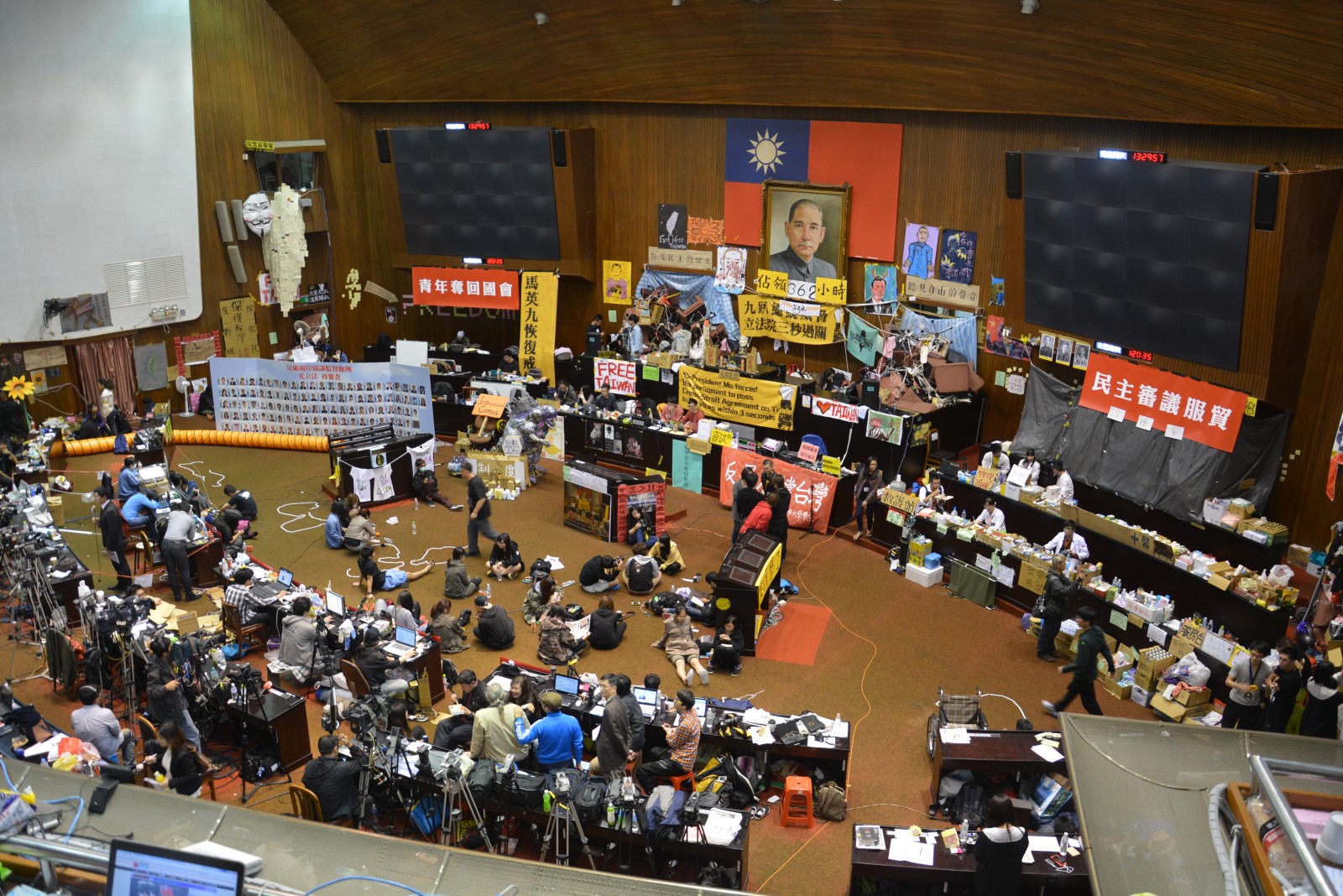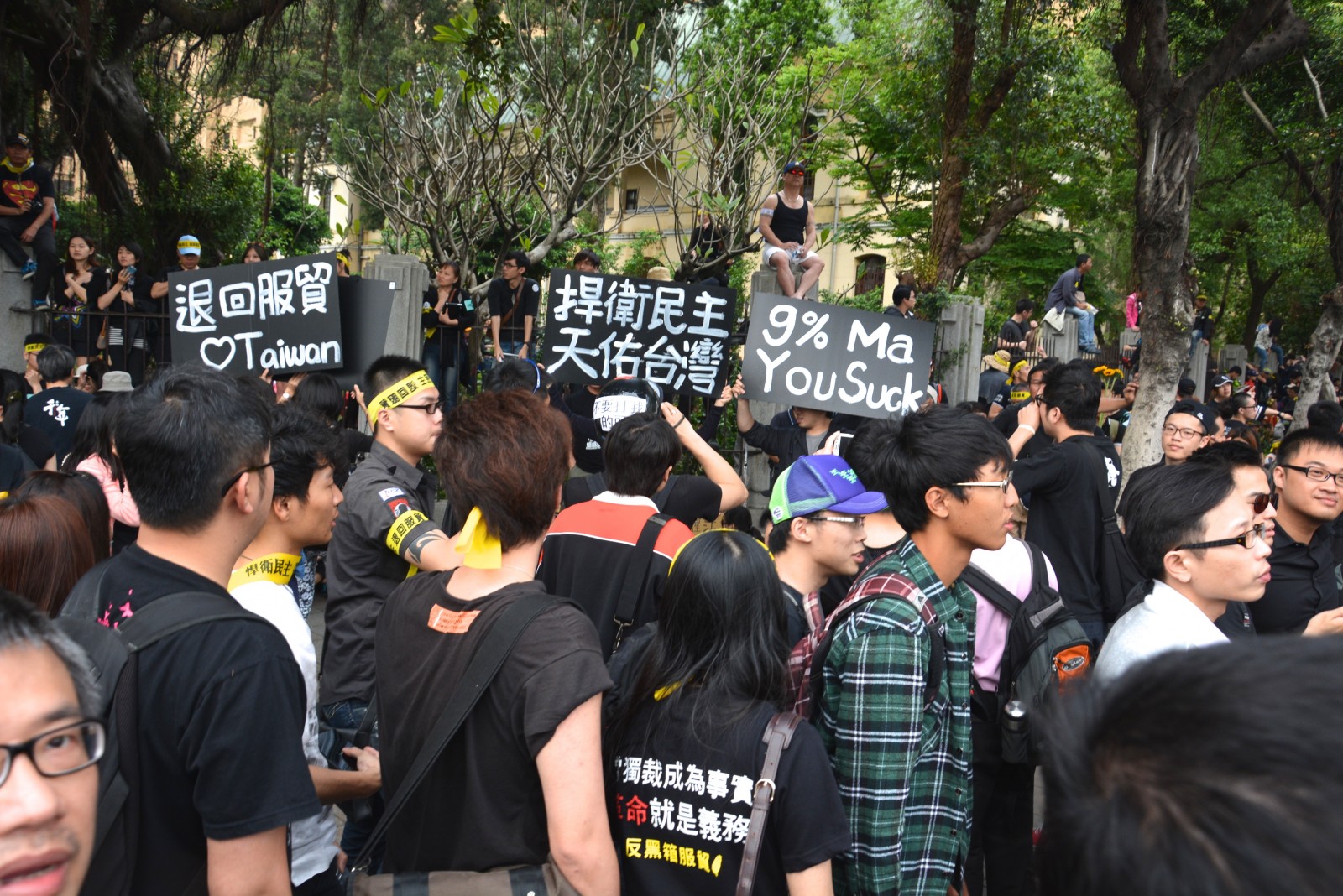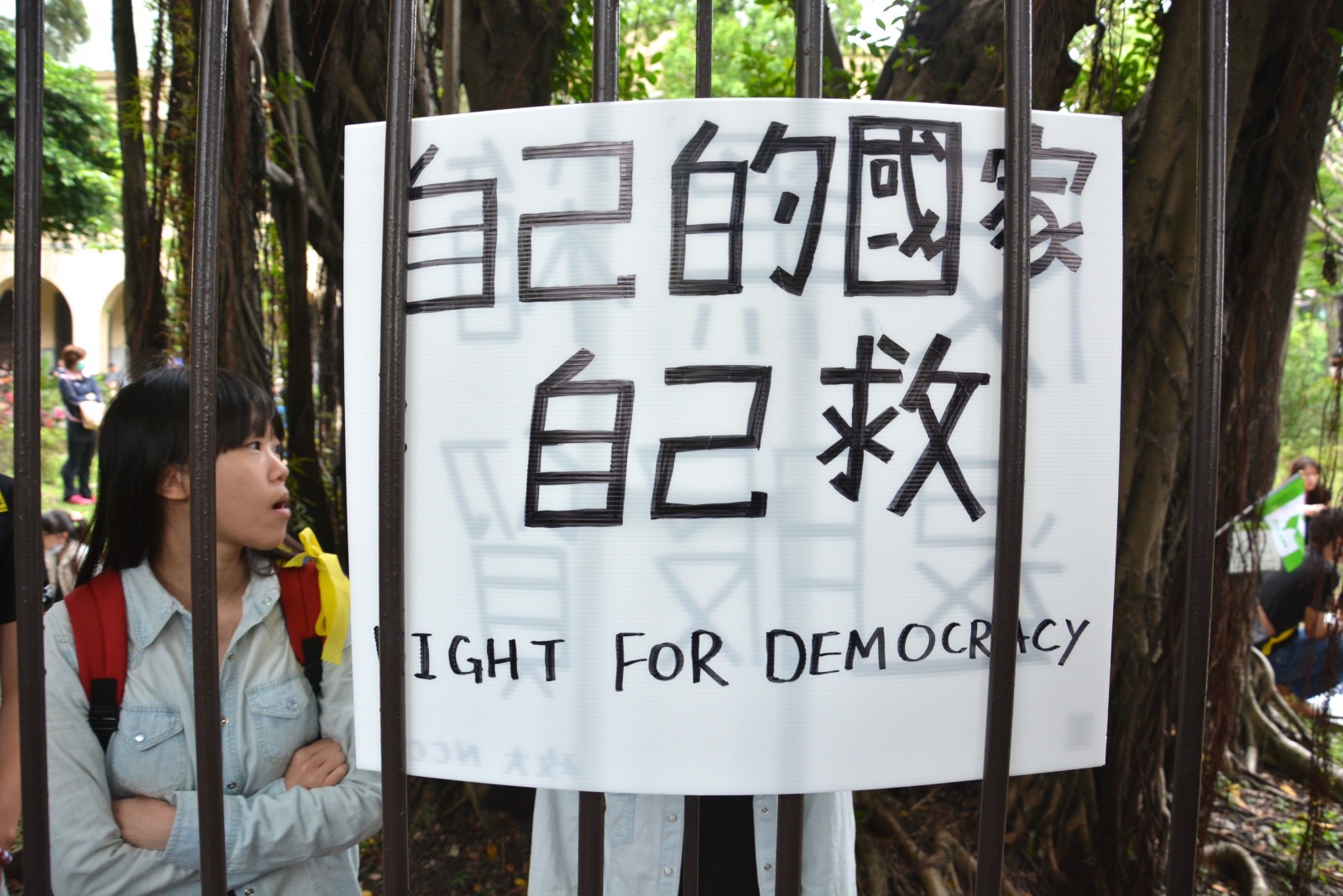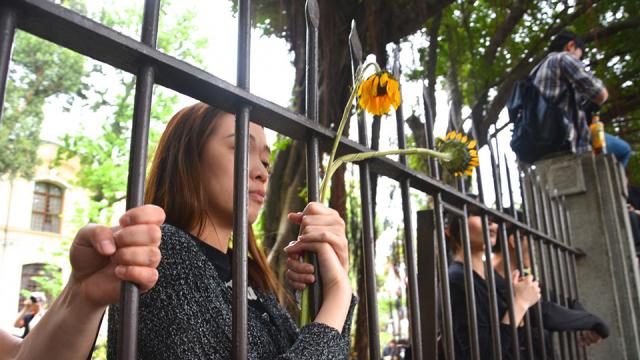
“Are we in danger?” asked Yanghua, a 24-year old from National Taiwan University, the island’s elite law school. She and I had met on the floor of the Legislative Yuan (Taiwan’s Parliament) during the second day of a student-led occupation that has since become known as the Sunflower Movement.
Two nights before, the weakly secured building had been stormed by student activists from the “Black Island Nation Youth,” who repelled police efforts to eject them, escorted the few remaining officers out and barricaded the doors with chairs and rope.
The trigger for the student occupation on March 18 was the perceived flouting of parliamentary due process by Taiwan’s ruling party, the Chinese Nationalist Party (KMT), in its effort to push a major trade deal with China through the legislature.
In March, KMT legislators reneged on an agreement with Taiwan’s opposition party for an item-by-item review of the Cross-Strait Services Trade Agreement (CSSTA), which was negotiated behind closed doors and signed in Shanghai on July 21, 2013.
Instead, the convener of the review committee unilaterally declared that the review had passed and that the bill would be submitted to Cabinet for approval.
The services trade pact soon became the focus of broader concerns, specifically the impact that greater Chinese penetration in Taiwan’s economy would have on the island’s small- and medium-sized businesses, media freedom and freedom of expression. The students’ core slogan has been clear and consistent: “Withdraw the Trade Agreement, Protect Democracy.”
Their concerns over what they call "black box" politics struck a chord with the wider public, as tens of thousands of people rallied outside the parliament building in support. After a local florist donated a case of fresh sunflowers to the front lines of the protest, the largest student movement in Taiwan’s history had found its symbol.
Inside an Occupation
Yanghua and I quickly discovered that we had more than a few things in common. We had attended the same school and spoke the same languages, but above all we both belonged to a motley second wave of people that entered the barricaded interior of the building. Finding a way inside the occupied Parliament was not obvious, and not without risk for a foreign passport holder.
By the time I entered, the central building was loosely guarded by an emerging system of student security teams and patient, though confused police. Some sympathetic opposition legislators, who were still afforded the legal right to bring in people they claimed as their assistants, were also present. In fact, the legislators who showed up and began serving in shifts were themselves veterans of past Taiwanese democratic and feminist movements. Respecting the will of the younger generation, they helped people come and go as needed. Some other legislators I saw drop by to take selfies in the increasingly festive main hall, then made a rapid exit as Taiwan’s paparazzi media chased after them.
Members of key civic groups soon entered, including ad hoc volunteer medical and legal teams, as well as food supply and technical support crews led by students. Though he had nothing to do with starting the protests, order was maintained by Parliament speaker Wang Jin-Pyng, who rejected Ma’s request to evict the occupiers.
Meanwhile, the scene outside the Legislature filled with sophisticated participation from new student and civic groups, including food distribution networks that provided blankets and raincoats for the bitter weather on Wednesday and Thursday nights; mobile recharging and wifi access centers, and free speech zones. Professors from across Taiwan held outdoor classes in the streets surrounding the Legislature.
Though we had different backgrounds and different stakes – Yanghua, a born-and-bred Taiwanese and me, a U.S. scholar who has spent most of his adult life in Taiwan and China – we, like tens of thousands more, soon found ourselves participating in a fast-growing activist community. Although clearly rooted in Taiwan’s long history of social democratic action, its rapid expansion suggests that the movement may now even transcend ethnic or even national affiliations.
Indeed, mainland Chinese and Hong Kong students joined their classmates inside the occupied parliament from nearly the beginning of the movement. Tian’anmen protest leaders Wang Dan and Wu’er Kaixi entered the compound the second night to express their support for the students. And people from Shanghai to Brazil connected through rapidly developing ad hoc volunteer crews using new media channels like Facebook, Google, LINE and more.
Sunflower sympathizers in Taiwan and beyond turned their Facebook profile pictures black in solidarity. A collaborative online platform, g0v.today, was set up via Hackpad to consolidate and update information and video feeds in both Chinese and English. As of Monday it had over 1,900 collaborators.
As much as these tools have enabled activists to spread their message, they have also been used to smear students. Within Taiwan, volleys of text messages were sent attempting to link Black Island student leaders Chen Wei-ting and Lin Fei-fan to the opposition DPP’s past presidential candidate, Tsai Ying-wen, a legal scholar and past official who has largely stayed out of the fray.
Meanwhile, information outside of Taiwan has been surprisingly hard to access. Across the Strait, most of China remains behind the Great Firewall, with little to no coverage in state-owned media. Globally, posts to Reddit, Youtube, and other influential sites coming from within and beyond the Occupied Parliament seem to have been professionally down-voted, manipulated by forces few fully understand.
As for the international corporate media, instead of arriving en masse to cover a story with major geopolitical importance and export potential, their attention has remained focused on a missing Malaysian plane and a crisis in Ukraine.
Concerned about the trade pact’s implications not only for free speech in Taiwan, students express legitimate worry that the global media is also afraid of China’s economic might, and that they are being abandoned by a world which has chosen to turn an apathetic ear to their cries.
While few students, or perhaps not any at all, seem to fully understand the trade pact, enough had sufficiently deep misgivings about it to employ what have been termed “extra-democratic means” to block its ratification.
It is important to stress that few people I’ve spoken with inside, including opposition legislators, were particularly anti-trade or even anti-China. Most simply expressed a wish to have more information and more time to consider what was best for Taiwan’s people. In civil society and academia, many people have expressed concern that this pact might be a backdoor means of selling out Taiwan’s hard-fought democracy and high quality of life to the benefit of oligarchs on both sides of the Taiwan Strait.
The buyer: an authoritarian Chinese regime no longer simply threatening Taiwan with words and missiles, but the more supple forces of economic takeover. The bystander: The U.S., Taiwan’s ambiguous patron since overseeing the 1945 transition of sovereignty from imperial Japan to the KMT.
Following Ma’s election in 2008, the pace has quickened, with Taiwanese politicians and capital flowing ever more quickly into China and vice versa.
It is not only the Sunflowers that are confused about such political and economic machinations. One week prior to the revolt, I was with a group of U.S. scholars who had the privilege of meeting President Ma Ying-jeou in person. We asked him how he expected Taiwan’s free-wheeling media culture to change, should the services trade pact pass and the media sector be explicitly opened to investment by capital-rich state-owned Chinese enterprises.
Ma either misunderstood or simply ignored our question, repeating a formulaic mantra about the pact’s potential for job creation. Like the student protesters of Black Island Nation Youth’s core, some of us evidently felt that important questions were being ignored. This was all the more glaring given that Ma’s approval ratings had already plummeted to an astonishing 9% in September 2013. Taiwan’s hard-won democracy seemed imperiled.
On Sunday night, still without any response from President Ma, a group of protesters with unclear ties to Black Island stormed the Executive Yuan, Taiwan’s cabinet building. While it was a startling, risky and arguably poorly planned move, its quick and violent suppression by riot police rallied the solidarity of students, teachers, civic groups and the general public. Some were, by then, calling for nationwide strikes to support the movement. A student leader of the cabinet occupation, Wei Yang, was eventually released from detention. Government response and media attention escalated it into a national crisis whose international ramifications continue to unfold.
Now entering the Sunflower Movement’s third week, it remains hard to predict how things will play out. As a participant and observer, this feels significantly different from any other protest I’ve witnessed in the past.
Indeed, the polite conduct, festive atmosphere, filial relationship with police, sophisticated use of high-tech tools, commitment to sanitation and recycling and a high degree of order in this dynamic environment recalls Burning Man more than Occupy, which lacked a consistent leadership core.
Such emergent order in the face of great pressure has already yielded remarkable results, including the largest political protest in Taiwan’s history on Sunday, March 30. According to the organizers’ count, corroborated by journalist J. Michael Cole, at least 350k peaceful protesters swelled the streets in front of the Presidential Office with songs, smiles and a sincere demand for the nation’s elected leadership to listen to demands of the students.
Actions were held in solidarity around the world, with thousands of demonstrators in Los Angeles, Tokyo, Paris, Berlin and beyond, shared through live feeds with protesters in Taipei.
Taiwanese public opinion seems increasingly in favor of the student movement, with a majority of TV poll respondents supporting a review of the trade pact and expressing disapproval of government conduct.
Online, multitudes of social media pages have been set up, including an “official” Sunflower Movement Facebook page was established and is currently actively sharing news in English, Chinese, Arabic, Polish, Portuguese, and more. The Facebook page has gained over 50,000 “Likes” in several days, and was quickly linked to an English-language Sunflower Movement Twitter account.
Japanese and other multi-lingual streams continue to be added. Other breaking stories are narrated through sophisticated new media outlets including 4am.tw and Taiwan Voice: channels of a broader, decentralized communications coalition.
There remains, however, great danger. International media have remained thin on the ground, underscoring Taiwan’s general diplomatic isolation. In a turn that would almost be self-parodic were it not so sinister, Chang An-le (aka “White Wolf”) the leader of the Bamboo Union mob and President of the (Taiwan and China) "Peaceful Reunification Party" called a press conference on March 31, threatening an invasion of the student-occupied Legislative Yuan on April 1.
While two weeks of peaceful parliamentary occupation and 500,000 protesters in front of the Presidential Office were not been enough to make the President listen, the threat of a 2,000-strong gangster army has been deployed to keep the din down on April Fool’s Day.
Despite the almost carnivalesque atmosphere at ground zero of the Sunflower movement, the view from inside makes this feel like a matter of life or death. The remarkable health and sophistication of Taiwan’s civil society, in the face of serious political, economic, and military challenges has allowed this movement to develop as far as it has.
Yanghua’s question, “Are we in danger?” reverberates.
With the immediate threat of gangster involvement, and the oligarchical and military swords of Damocles suspended over Taiwan, a peaceful outcome is far from certain. The stakes are high for the people of this democracy mired in political conflict, floating between the ambiguous and conflicting forces of the U.S., China, and global capital.
Yanghua, hang tight. You are not alone.
Peter Pan and Scott Writer were contributing editors to this story
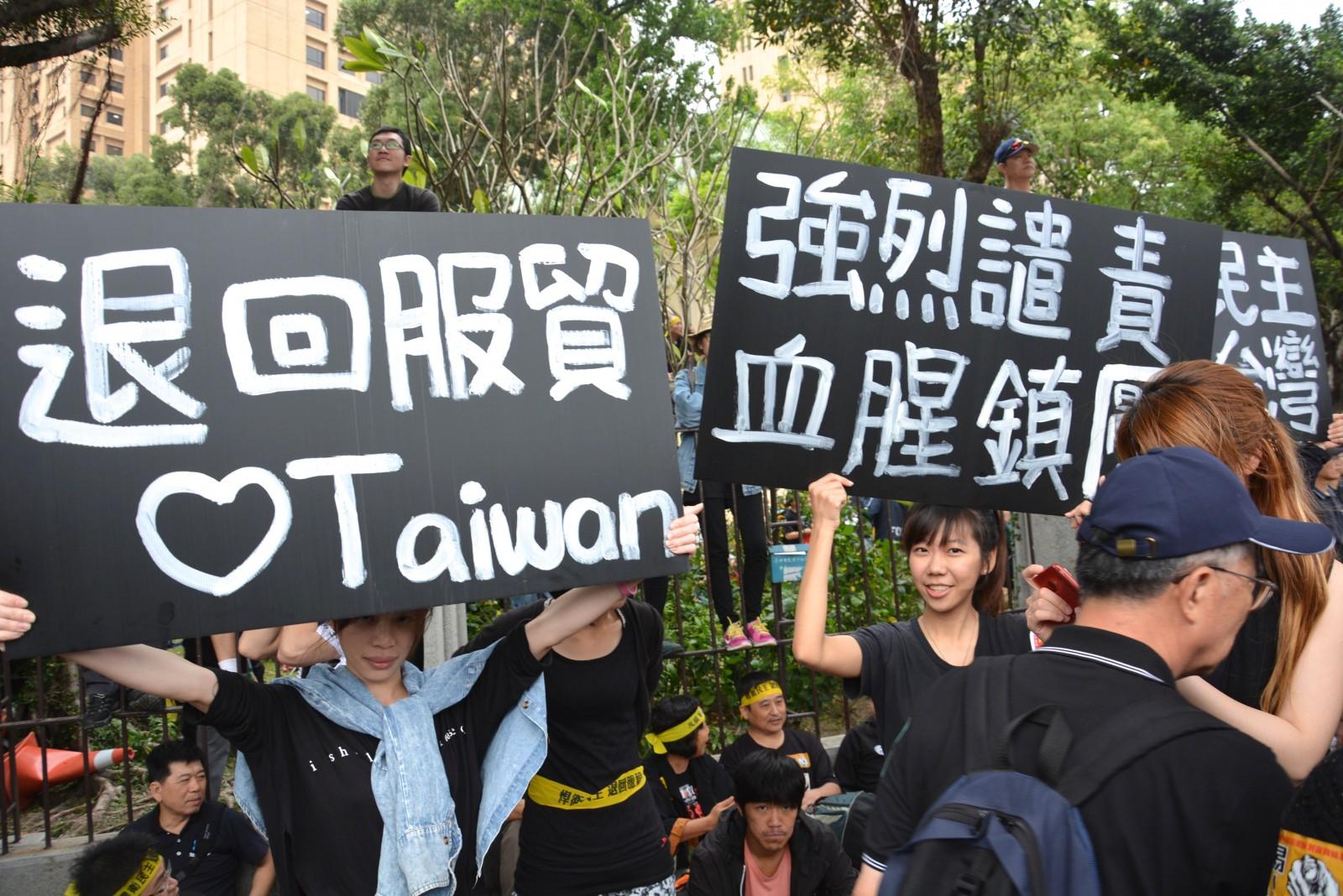
3 WAYS TO SHOW YOUR SUPPORT
- Log in to post comments

